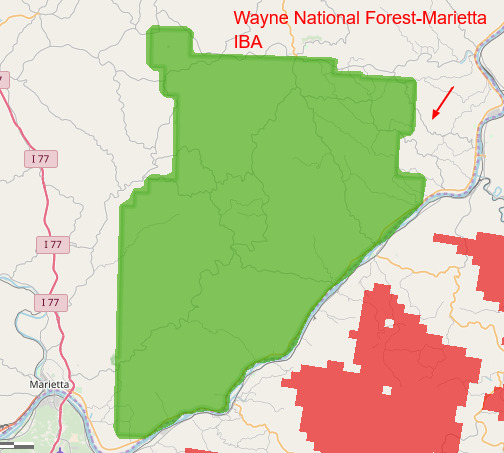Wayne National Forest-Marietta Important Bird Area
Wayne National Forest-Marietta
Important Bird Area
Explore in eBird
Entire Year – Spring – Summer – Fall – Winter
Locations
Washington
Wayne National Forest--Archers Fork Trail, Archers Fork Trailhead
Wayne National Forest--Hune Covered Bridge Campground and Trail
Wayne National Forest--Kinderhook Trail
Wayne National Forest--Leith Run Recreation Area
Wayne National Forest--Newell Run Mouth
Wayne National Forest--Newell Run Rd.
Wayne National Forest--Number Nine Rd.
Wayne National Forest--Peggs Fork Run
Willow Island Lock and Dam (Ohio)

About Wayne National Forest-Marietta Important Bird Area
The Wayne NF is located in southeastern Ohio in the foothills of the Appalachian Mountains and is comprised of approximately 239,000 acres. It is administrated in two Districts, made up of three separate, noncontiguous units (Athens and Marietta Units are in the Athens District; Ironton Unit is the Ironton District). Each unit has an individuality that makes the Wayne appear to be three forests instead of one, each somewhat characterized by their connection to the long history of mineral development. The Ironton area was known for its iron furnaces, the Athens and surrounding areas were extensively mined for coal, and the Marietta Unit is dotted by oil/gas wells.
The Wayne National Forest is the largest tract of public land ownership in Ohio. Its goal is to manage for all wildlife species through a variety of habitats – forest, wetland, grassland (reclaimed surface-mine), and shrubby fallow field areas. The most common habitat is deciduous hardwood. However, smaller rare areas of vegetation include a remnant tallgrass prairie area known as Buffalo Beats, a bottomland pin oak-swamp white oak community at Paines Crossing, and a post oak barren at Fradd Hollow.
Located northeast of Ironton District and adjacent to the Ohio River is the Marietta District, in Washington, Monroe, and Noble Counties. Here the flora is thicker, wilder, and the forest has the character of the river setting.
The Bird Survey Routes sourced above cover but a small portion of the Units but are spread out among various habitat types. The Wayne is important for a number of priority bird species, with its large blocks of forest providing strongholds for substantial breeding populations of many Appalachian specialties such as Cerulean Warbler and Worm-eating Warbler, along with Kentucky Warbler, Blue-winged Warbler, Louisiana Waterthrush, and Yellow-breasted Chat, Acadian Flycatcher, Wood Thrush, and Black Vulture. The Cerulean Warbler has been under consideration for Federal Endangered Species listing with the center of its distribution just miles away from the Wayne in Parkersburg, West Virginia. Wetlands found on the Wayne support several heron rookeries and waterfowl.
Surprisingly, on the reclaimed surface-mine lands, the Wayne also has significant populations of grassland specialties such as Henslow’s Sparrow and shrubby openings with Prairie Warbler.
From Wayne National Forest-Marietta Important Bird Area webpage